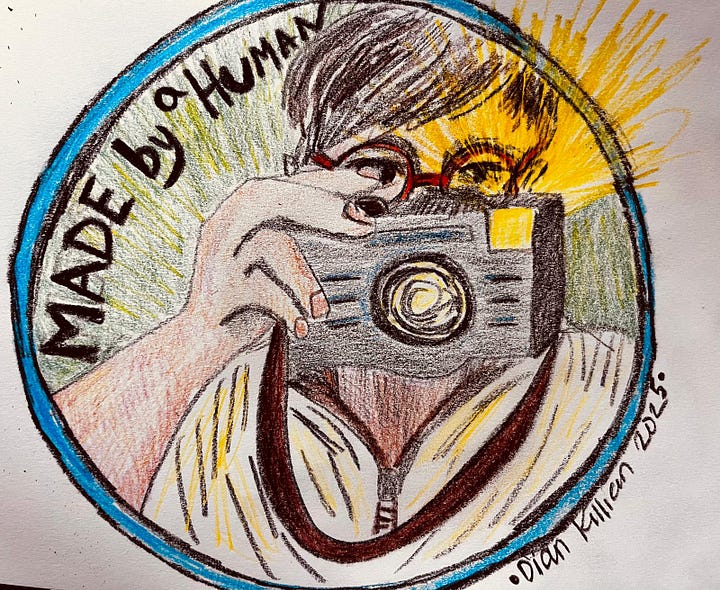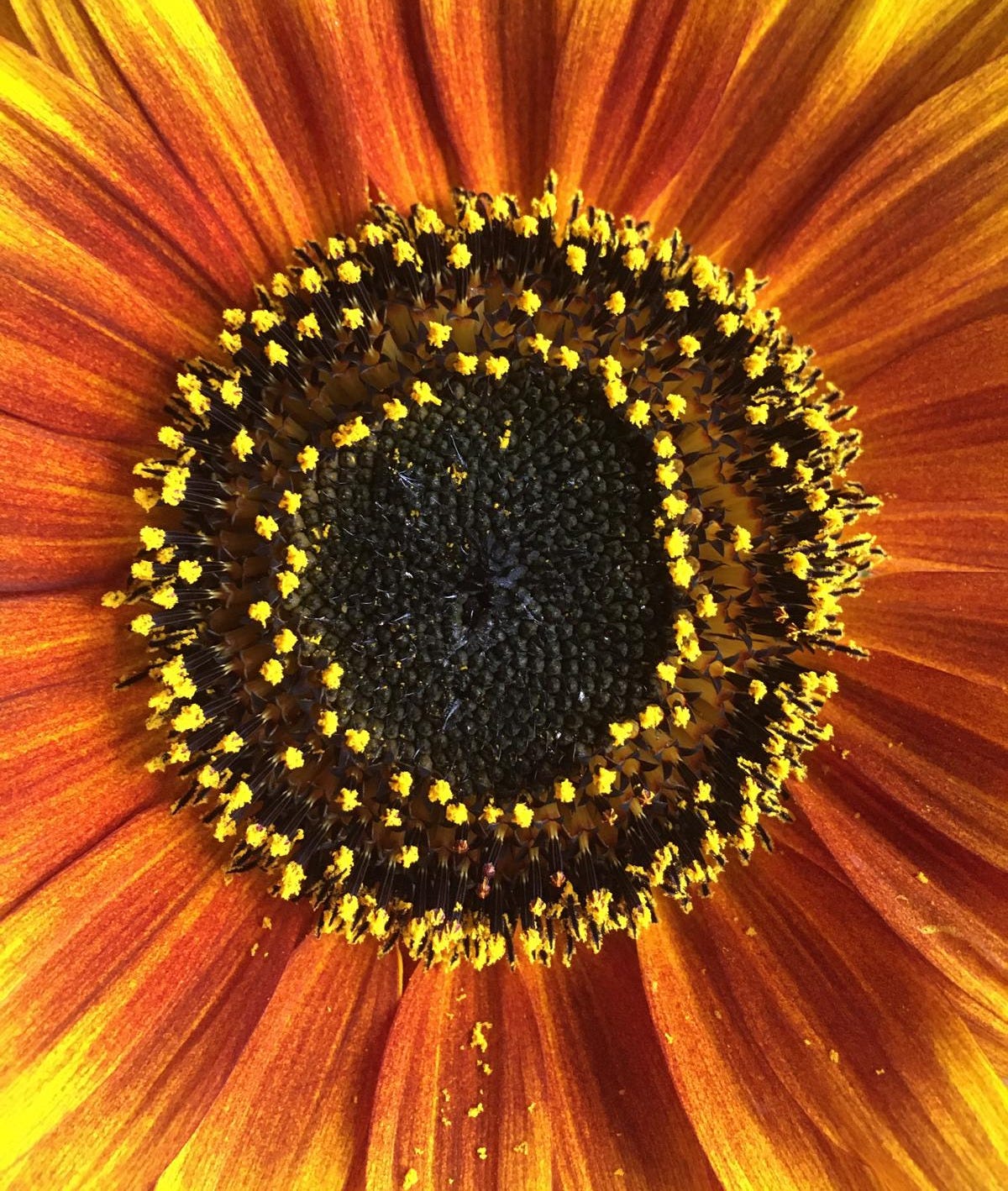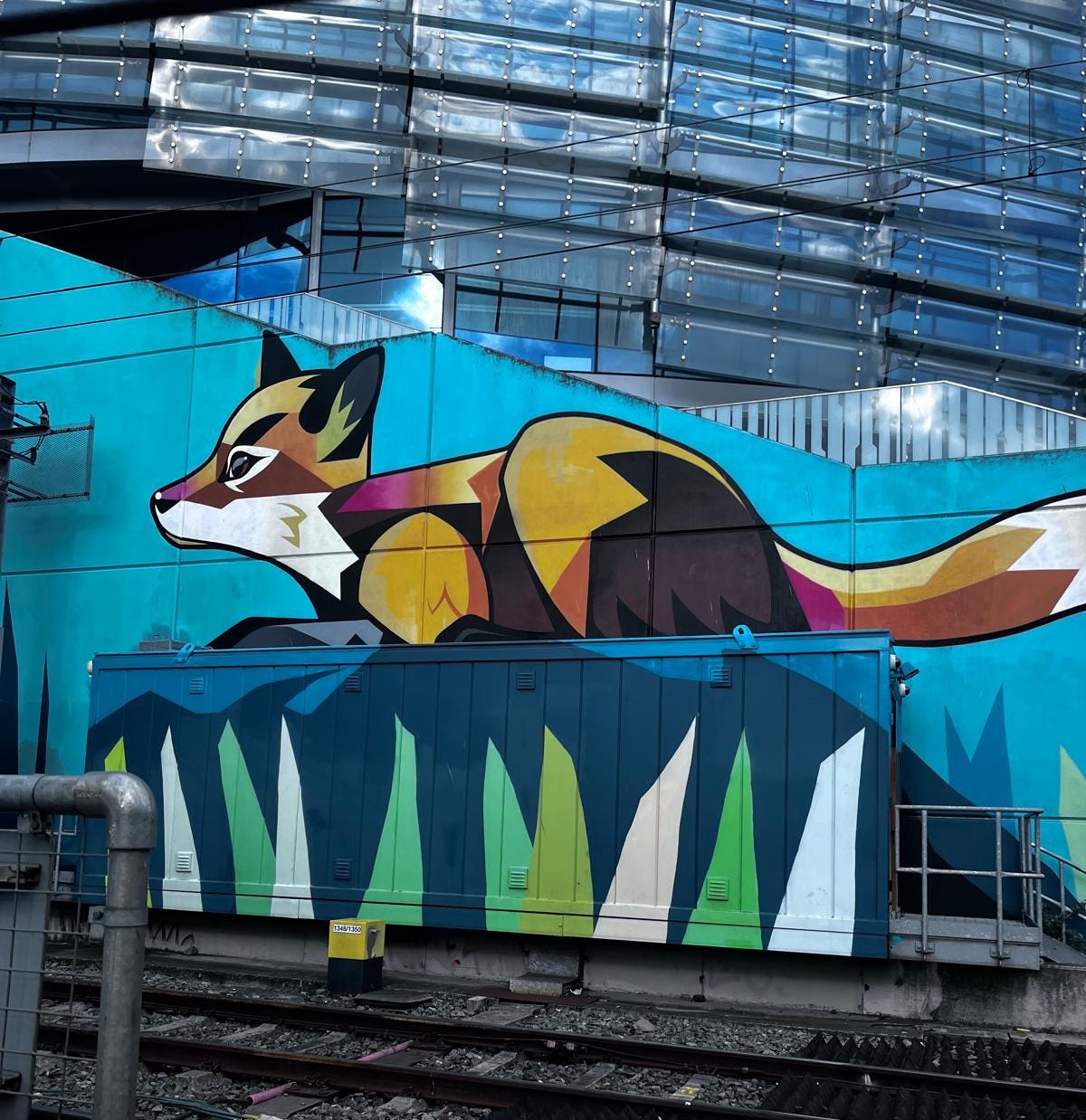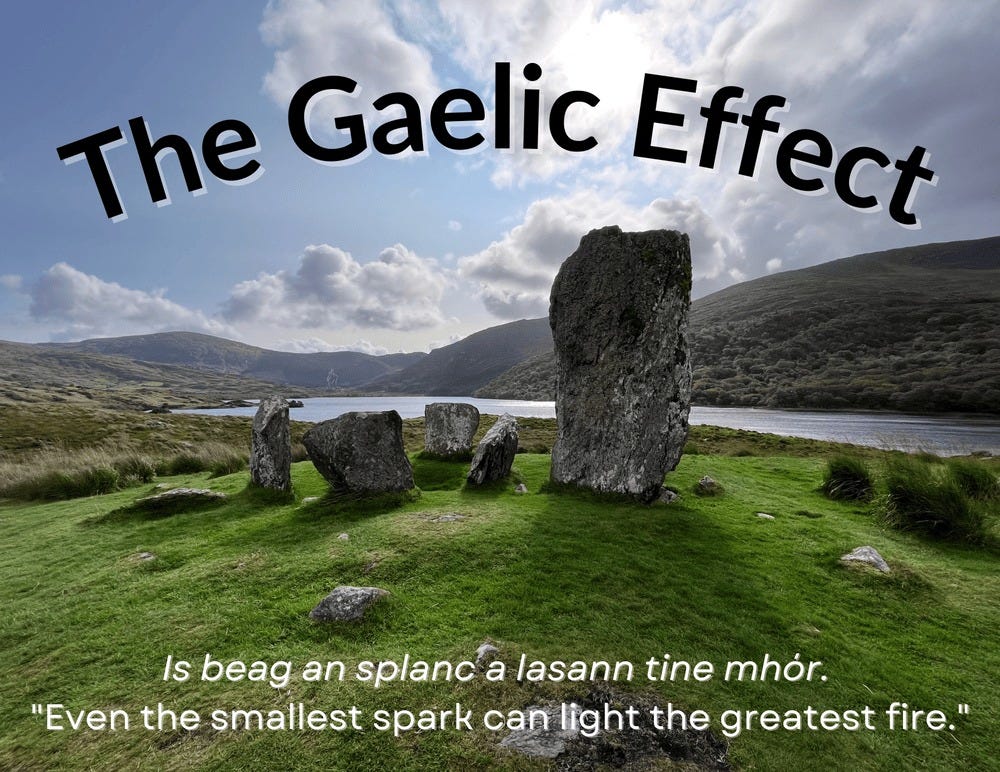Happy Beltane! Also known as Cétshamhain ('first of summer'), Beltane is when cattle were driven out to summer pastures. “Special bonfires were also kindled whose flames, smoke and ashes were deemed to have protective powers. […] Doors, windows, byres and livestock would be decorated with yellow May flowers, perhaps because they evoked fire.” The word Beltane itself is “proposed to derive from a proto-Celtic *belo-te(p)niâ, meaning 'bright fire'. […] *belo- might be cognate with the English word bale (as in bale-fire) meaning 'white', 'bright' or 'shining'. (Wiki)
Fires were lit because Beltane is a “Cross Quarter Day, half way between the Spring Equinox and the Summer Solstice. As such, it’s connected to the sun (the biggest fire of all) and its fullness during summer. Echoing Brú na Bóinne (Newgrange)—which has an inner chamber that illuminates on the winter solstice, the Beltany (Beltony) Stone Circle in the North West of Ireland has a decorated stone that only aligns with the sun on the sunrise at Beltane. Thus, “Beltane is associated with the lighting of hilltop fires in a rekindling of the sun.” (Newgrange) (For more about the sun in indigenous Irish culture, see The Sun Stands Still.)
Given that rituals were “performed on Beltane to protect cattle, people and crops, and to encourage growth” (Wiki), today’s Gaelic Effect will focus on the natural world, and specifically some of my favorite words in Irish for animals and insects. In past essays I’ve written about how observational the Irish language is—rather than say “I love you” for example, it’s more common in Irish to describe your feelings through physical descriptions, such as “pulse of my heart” (see The Body Sings Electric); the word for “excuse “ in Irish is “half a story” (see Half a Story), rather than “should,” you say it’s “good with me” (Don’t Should on Me). Given this level of observation, as Hector Ó hEochagáin says, “When you speak in Irish, every word is a tiny poem that reveals a new perspective.” Each Irish word is comhla bhreac—a magic doorway (traditionally a doorway to the fairy world and literally meaning “speckled door” [Magan]). This is one of the delights of learning Irish: discovering these peep holes. The names of plants and animals are especially rich in this particular magic.
The word for “fox” in Irish is sionnach (coming from Old Irish through Proto-Celtic *senos (“old one”) [Wiki]. The fox is also known as madra rua (“red dog”). Both the original meaning in Proto-Celtic and madra rua have qualities (for me) of affection and respect. It’s estimated that the red fox has lived in Ireland 400,000 years, so the fox is indeed old [Conserve]. They also are very common, even in urban centers. It’s not unusual to see a madra rua or even a pair crossing the road under the moon (and the street lights) of Dublin, even close to city centre. (Last year I saw two crossing Marlborough Street around 8pm at night.) A testimony to their presence in Dublin, foxes also turn up via street art in the capital city. (One example above, is near the Aviva stadium.) If you’ve never heard foxes cry—especially when mating—it gives you an idea of what a banshee’s keening might sound like. It’s interesting that the etymology of “fox” in English is also observational, if you go back all the way to the Proto-Indo-European origin, púḱsos (“the tailed one”). I like this as much as “red dog” yet this observational name is no longer accessible on the surface, as it is in Irish. You need to dig for it.
Wolves were once so common in Ireland that the whole country was known as “wolf-land.” In indigenous Irish culture, they were respected and revered, often featuring in myths and stories [Wild]. The Irish word for wolf is madra allta or faolchu, both meaning “wild dog.” Faol literally means wild or untamed. [Magan] The wolf is also known as mac tire, the son of the land. Some say this comes from the wolf being so solitary [Wild]; Manchán Magan has a different theory—that it’s because “wolves were once believed to occasionally turn into humans, and there are many tales in Irish mythology of wolves being able to talk or act like people” [Magan]. Among all the destructive things Cromwell did to/in Ireland, he played a direct role in the final extinction of the wolf here, putting a bounty on its head. The last wolf was killed in County Carlow in 1786 [Wild]. There is now discussion about reintroducing the “son of the land” back to Ireland for biodiversity [RTÉ].
Since we’re talking about different “dogs,” madra crainn (tree dog) is how you say “squirrel” in Irish; dobharchú or madra uisce is “otter” (both words mean “water dog,” cú another word for “dog” or “hound”); a lao mara (literally “sea calf”) is a baby seal (an adult seal is rón). Since we’re talking about seals, the word for “jelly-fish” in Irish is smugairle róin, “seal spittle” or “snot.” And since we have “tree dog” for a squirrel, a “pine marten” is cat crainn, a “tree cat.”
Is teann gach madra ag a dhoras féin. —Every dog is bold at his own door.
There are also lovely names in Irish for insects that truly offer a comhla bhreac, a magical door, into their tiny worlds. Butterfly in Irish is féileacán which comes from Old Irish for “little flying creature.” A féileacán oíche (a night butterfly) is a moth. Míol is a louse and a míol mór (a “big louse”) is a whale. (I love how Irish goes from tiny to to grand in this one word—and I suppose a whale does look like a big louse?) Similarly, “spider” in Irish is damhán alla which literally means “wild little ox.” According to Mancán Magan, this word has been in use at least for 1,200 years. [Magan] My all time favorite animal word in Irish though is “lady bug” (“lady-bird” in Hibernian English). Her name in Irish, bóin de, means “God’s little cow,” probably because of her spots. She’s also known as bo shamhraidh (summer cow), ciarog na mbeannacht (beatle of the blessings) and cearc mhuire (the Virgin Mary’s hen). [Magan]
The Butterfly is one of my favorite Irish tunes. You can truly hear the stop-and-start of a butterfly’s flight in the melody. Take a listen here:
Tree squirells, seal snot, night butterflies and God’s little cow—what does all this have to do with saving the world—the mission of The Gaelic Effect? Being grounded in the natural world, in our bodies, and the here and now are crucial to our survival. Each time we see the world anew—or simply see it at all—is an opportunity for presence, joy, reverence and awe—which I consider crucial to stewarding (rather than using) the earth. We can’t save what we don’t see—or love. Just as much, we need fun, play and delight in our lives. We are part of the ecosystem. Surely our happiness and aliveness (in right relation to other living beings on the planet) matters too.
Frank MacEowen writes:
“The image of the forest speaks of a softer way of being as well as the unseen integrity inherently woven within the harmonious bonds of relationship that shape the ecosystem. The harmonious bond of which I speak is the original language of the planet.” (forward to The Salmon in the Spring: The Ecology of Celtic Spirituality)
As explored throughout The Gaelic Effect, Irish grounds us in the natural world, places us in situ in relation to it. It also orients us in very different ways to relating to other human beings and ourselves—with connection, community and interdependence (see Sheltering Each Other). As someone with a background in Nonviolence, my thoughts go to Martin Luther King Jr.’s concept of the beloved community:
“a community where all people are respected, cared for, and treated as equals. A beloved community where there is no space for injustice, prejudice, or discrimination. Rather, it is a space for economic and social justice, peaceful conflict resolution, and the reconciliation of humanity.” [Northeastern]
For me, just as the Center for Nonviolent Communication at one point expanded its mission from “holding the needs of all humans with care” to “holding the needs of all living beings with care,” this extends to all life on the planet. More:
“While this is a common notion that many of us embrace, the beloved community that King spoke of is more than just an ideology. In order for us to have such a beloved community, King said we must all “become outspoken champions.” [Northeastern]
How do I become a champion of this kind—and for all beings on the planet? It’s a tall order—and a question I have continued to ask myself throughout my life.
For now, my main strategy is sharing The Gaelic Effect. I hope it makes a difference for you—and, if nothing more, brings you some insight and joy.
Thanks as always for reading and for your support.
With warm wishes from Dublin on Beltaine,
Dian i mBaile Atha Cliath
P.S. As always, Irish words are hyperlinked to https://www.abair.ie/ga where you can hear the pronunciation in the dialect of your choice.
P.P.S. Become a paid subscriber to The Gaelic Effect (for just $3.50 a month!) and be entered for one of three chances to win the beautiful art book, We will Never be Together. Drawing in June!
You can also support The Gaelic Effect and its mission by making a one-time donation by clicking anseo (here).










Strangely enough, I was at the Beltany stone circle in Donegal round the time of the other cross quarter festival, Samhain. (My husband is from that area.) It is such a potent place.
Nice article, thanks. I especially love the "Human Intelligence" images at the end. :-)